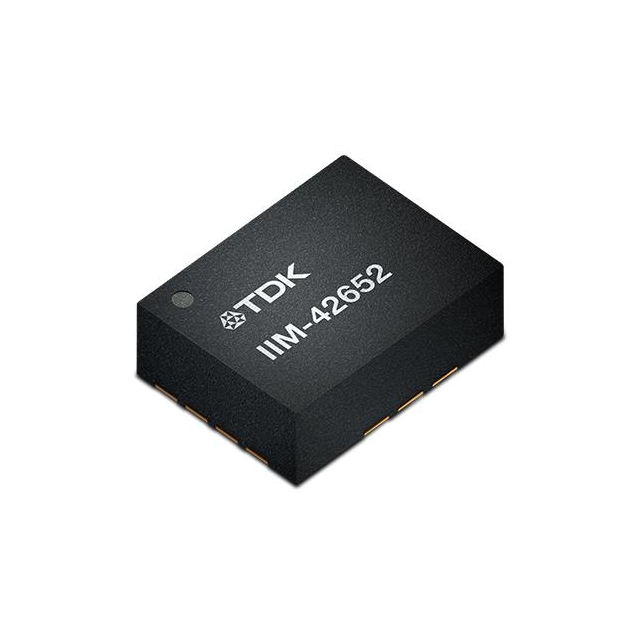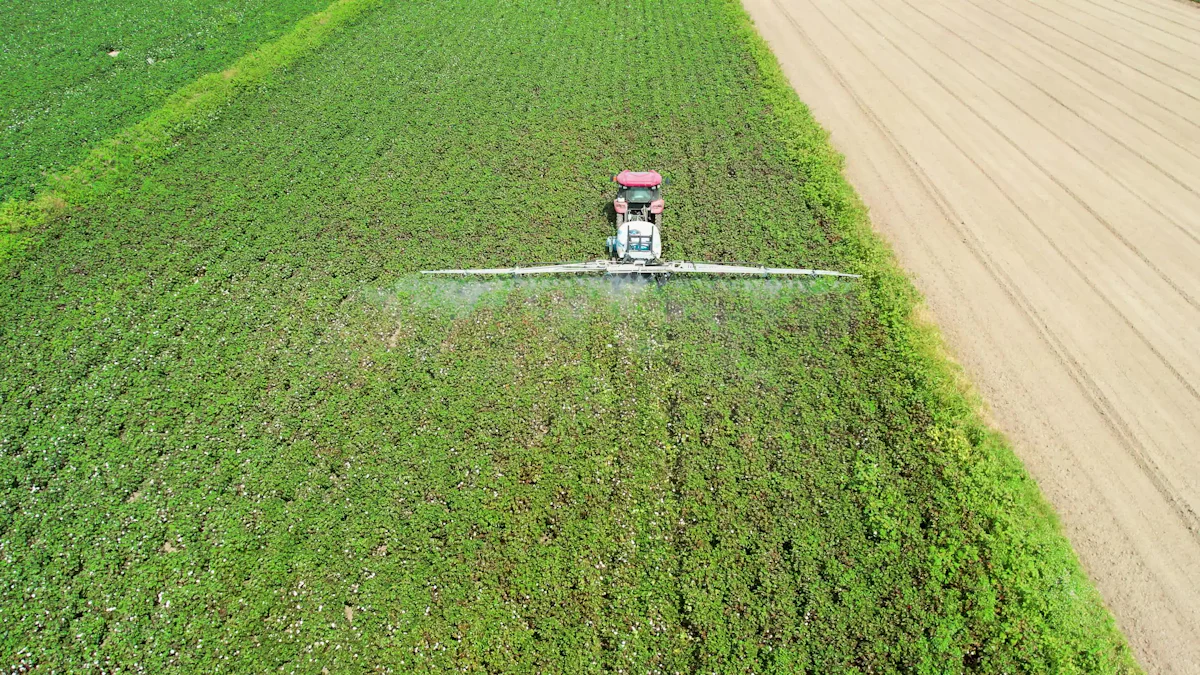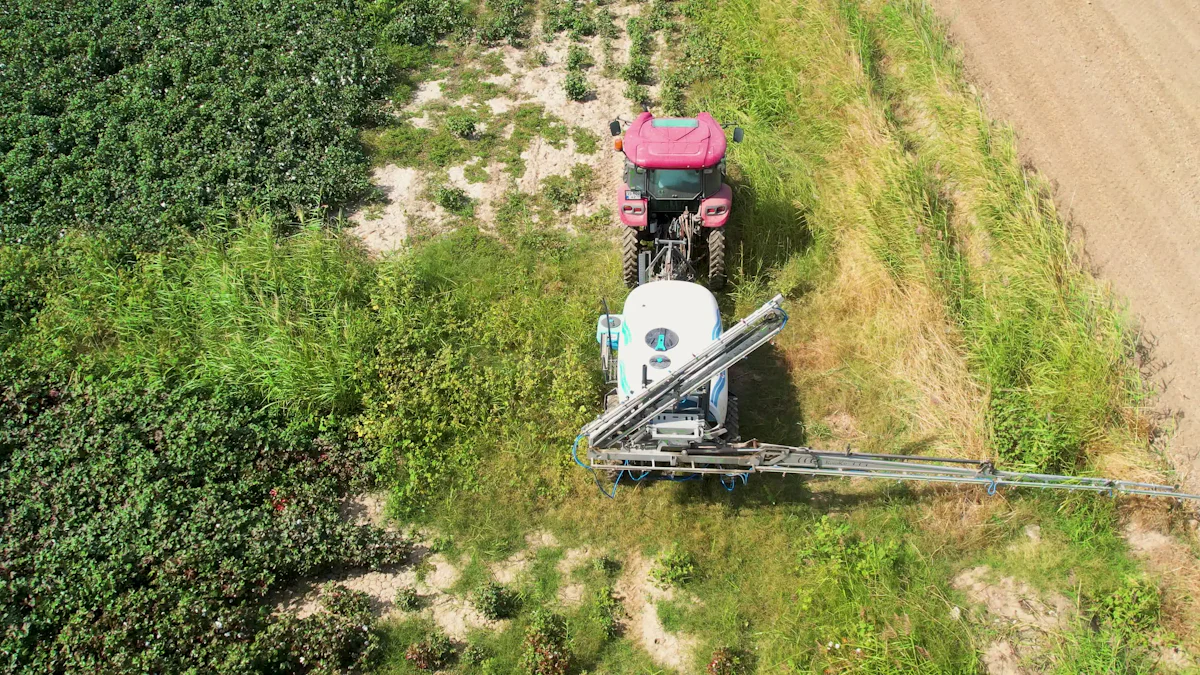How IIM-42652 Revolutionizes Precision Agriculture

The IIM-42652 sensor is reshaping precision farming by providing advanced tools for smarter agricultural practices. Its ability to track motion and monitor environmental conditions helps farmers optimize resources and reduce costs. This sensor enables precision farming to achieve higher efficiency and sustainability.
Globally, the adoption of precision agriculture technologies has significantly impacted farming. These technologies have already prevented 10.1 million metric tons of emissions. Broader adoption could avoid an additional 17.3 million metric tons. In the U.S., the adoption rate of precision farming equipment rose from 46% in 2008 to 86% in 2023. However, only 27% of farms currently use these practices, highlighting the potential for further growth.
By integrating the IIM-42652, farmers can improve crop yields and streamline operations. Its innovative design supports precision farming by delivering accurate data for better decision-making.
Key Takeaways
The IIM-42652 sensor enhances precision agriculture by providing real-time data, enabling farmers to optimize irrigation and improve crop yields.
Farmers can significantly reduce resource wastage and operational costs by using the sensor's accurate monitoring capabilities for water, fertilizers, and pesticides.
The sensor's compact and energy-efficient design allows for seamless integration with existing farming systems, making it easier for farmers to adopt advanced technologies.
By detecting environmental changes early, the IIM-42652 helps farmers intervene promptly, preventing crop loss and ensuring healthier harvests.
Adopting the IIM-42652 empowers farmers to achieve greater efficiency and sustainability, aligning with the goals of modern agriculture.
Overview of the IIM-42652
Key Features and Specifications
3-axis gyroscope and accelerometer integration
The IIM-42652 combines a 3-axis gyroscope and a 3-axis accelerometer in a single compact package. This integration allows the sensor to capture precise motion data, making it ideal for applications in precision agriculture. The gyroscope measures angular velocity, while the accelerometer detects linear motion and tilt. Together, they provide comprehensive motion tracking capabilities.
High-precision motion tracking and tilt sensing
The sensor delivers high-precision motion tracking, enabling accurate tilt sensing and orientation detection. This feature is critical for monitoring machinery alignment and ensuring optimal equipment performance in agricultural operations. With support for high-speed data rates up to 25 Mbps in DDR mode, the IIM-42652 ensures rapid and reliable data transmission.
Compact, durable, and energy-efficient design
The IIM-42652 boasts a compact size of 2.5 × 3 × 0.91 mm, making it easy to integrate into various farming systems. Its durable design operates reliably across a wide temperature range of -40 °C to 105 °C, ensuring consistent performance in diverse agricultural environments. The sensor's energy-efficient design, supported by a 2K-byte FIFO, minimizes power consumption, extending its operational lifespan.
Unique Selling Points
Low power consumption for extended use
The IIM-42652 features a low-power mode that reduces energy usage without compromising performance. This capability is particularly beneficial for battery-powered devices like drones and automatic guided vehicles (AGVs) used in precision agriculture.
Seamless compatibility with IoT and smart systems
The sensor supports versatile interface options, including I3C℠, I²C, and SPI, allowing seamless integration with IoT platforms and smart farming systems. This compatibility enables farmers to connect the sensor with existing technologies, enhancing the efficiency of their operations.
Real-time data processing for actionable insights
Real-time data processing allows the IIM-42652 to provide actionable insights that improve decision-making. By analyzing motion and environmental data instantly, the sensor helps farmers optimize resource use, reduce costs, and maximize crop yields. For example, real-time data can guide irrigation schedules, reducing water waste and preserving soil health. This capability also minimizes dependence on unpredictable weather conditions, giving farmers greater control over their operations.
Applications in Precision Agriculture

Soil Monitoring
Measuring soil moisture and temperature for optimal irrigation
Accurate soil moisture and temperature measurements play a vital role in improving irrigation practices. The IIM-42652 sensor provides precise data, enabling farmers to tailor irrigation schedules to the specific needs of their crops. This approach leads to several benefits:
Improved yields by ensuring crops receive adequate water.
Enhanced grain quality through consistent hydration.
Water conservation by avoiding over-irrigation.
Reduced nutrient leaching, which preserves soil fertility.
By leveraging these insights, farmers can optimize water usage and maintain healthier soil conditions. This capability supports the broader goals of precision agriculture by promoting resource efficiency and sustainability.
Enhancing water usage efficiency and reducing waste
The IIM-42652 helps farmers monitor soil conditions in real time. This data allows them to apply water only where and when it is needed. As a result, water waste decreases significantly. Additionally, this targeted approach prevents over-saturation, which can harm crops and degrade soil structure. Farmers using this sensor can achieve better water management, ensuring long-term agricultural productivity.
Crop Health Assessment
Detecting plant stress through motion and environmental data
The IIM-42652 sensor detects subtle changes in environmental conditions that may indicate plant stress. For example, it can identify irregularities in soil moisture or temperature that affect crop health. Early detection of these issues allows farmers to take corrective actions before significant damage occurs.
Supporting early intervention to prevent crop loss
By providing real-time data, the sensor enables farmers to address problems like drought stress or nutrient deficiencies promptly. Early intervention minimizes crop loss and ensures healthier harvests. This proactive approach aligns with the principles of precision agriculture, where timely decisions lead to better outcomes.
Machinery Optimization
Improving equipment navigation and positioning
The IIM-42652 enhances machinery performance by providing precise motion tracking and tilt sensing. This feature ensures accurate navigation and positioning of agricultural equipment, such as tractors and planters. Improved alignment reduces errors during planting or harvesting, leading to more efficient operations.
Reducing fuel consumption and wear-and-tear
Optimized machinery navigation also reduces unnecessary movements, lowering fuel consumption. Additionally, smoother operation minimizes wear-and-tear on equipment, extending its lifespan. These benefits contribute to cost savings and support sustainable farming practices.
Drone and AGV Integration
Monitoring crop health and field conditions using drones
Drones equipped with advanced sensors have become essential tools in precision agriculture. These devices collect critical data on crop health, soil conditions, and field performance. Farmers can use this information to make informed decisions and improve productivity.
The table below highlights how drones enhance agricultural monitoring:
Feature | Function | Benefit |
|---|---|---|
Thermal Cameras | Measure crop canopy temperature | Identify plant stress areas needing immediate attention |
NDVI (Normalized Difference Vegetation Index) | Analyze plant health using multispectral images | Detect stressed or diseased plants early |
High-Resolution Imaging | Capture detailed field visuals | Assess soil erosion, pest infestations, and irrigation issues |
Drones also enable farmers to monitor large fields quickly. This efficiency reduces the time and effort required for manual inspections. By identifying problem areas early, farmers can intervene promptly, preventing crop loss and improving yields.
Managing field operations with automatic guided vehicles
Automatic guided vehicles (AGVs) streamline field operations by automating tasks like planting, fertilizing, and harvesting. These vehicles rely on sensors like the IIM-42652 to navigate fields with precision. Accurate motion tracking ensures AGVs maintain proper alignment, reducing errors during operations.
AGVs also optimize resource usage. For example, they apply fertilizers and pesticides only where needed, minimizing waste and environmental impact. Their consistent performance reduces reliance on manual labor, lowering operational costs.
Farmers benefit from the durability and energy efficiency of AGVs equipped with the IIM-42652. These vehicles operate reliably in challenging conditions, ensuring uninterrupted productivity. By integrating drones and AGVs, precision agriculture achieves higher efficiency and sustainability.
Benefits of Using IIM-42652
Improved Efficiency
Streamlining farming operations with precise data
The IIM-42652 sensor provides farmers with accurate, real-time data, enabling them to make informed decisions. This precision eliminates guesswork in farming operations. For example, the sensor helps optimize irrigation schedules, ensuring crops receive the right amount of water. Farmers can also monitor machinery alignment and field conditions with ease. These capabilities streamline operations, saving time and improving productivity.
Reducing manual labor and operational delays
By automating data collection and analysis, the IIM-42652 reduces the need for manual inspections. Farmers no longer need to spend hours checking soil conditions or crop health manually. The sensor’s integration with IoT systems allows for remote monitoring, minimizing delays caused by human error. This reduction in manual labor frees up resources for other critical tasks, enhancing overall efficiency.
Cost Savings
Minimizing resource wastage through accurate monitoring
The sensor’s precise monitoring capabilities help farmers use resources like water, fertilizers, and pesticides more efficiently. By applying these inputs only where needed, farmers can avoid unnecessary expenses. This targeted approach not only reduces costs but also prevents overuse, which can harm crops and soil.
Lowering long-term operational expenses
The IIM-42652’s durable and energy-efficient design ensures reliable performance over time. Its low power consumption reduces energy costs, especially for battery-powered devices like drones and AGVs. Additionally, the sensor’s ability to optimize machinery usage minimizes wear-and-tear, lowering maintenance expenses. These features contribute to significant long-term savings for farmers.
Environmental Sustainability
Reducing water and chemical usage for eco-friendly farming
The IIM-42652 supports sustainable farming by promoting efficient resource use.
It uses less water while increasing productivity.
It enhances soil organic matter and water retention.
It prevents soil erosion and reduces greenhouse gas emissions.
This approach not only conserves resources but also protects the environment.
It reduces water usage and pollution.
It enhances biodiversity and soil health.
It supports economic viability by lowering input costs.
It promotes resilience to climate change.
These benefits align with the goals of precision agriculture, ensuring long-term sustainability.
Supporting sustainable agricultural practices
The sensor enables farmers to adopt practices that balance productivity with environmental stewardship. By reducing chemical usage, it minimizes pollution and fosters healthier ecosystems. Its ability to optimize resource use also supports sustainable crop production, ensuring food security for future generations.
Comparison with Other Sensors

Performance Metrics
Superior accuracy and reliability in agricultural settings
The IIM-42652 stands out among sensors in agriculture due to its exceptional accuracy and reliability. Several features contribute to its superior performance:
Integration of a 3-axis gyroscope and a 3-axis accelerometer ensures precise motion tracking.
An extended operating temperature range (-40 °C to 105 °C) makes it suitable for diverse agricultural environments.
A 2K-byte FIFO reduces traffic on the serial bus interface, enhancing efficiency.
Programmable full-scale ranges allow flexibility, enabling the sensor to adapt to various applications.
These attributes make the IIM-42652 a dependable choice for precision agriculture, where consistent and accurate data is critical.
Faster data processing for real-time decision-making
The IIM-42652 processes data faster than many competitors. Its high-speed interface options, including I3C, I²C, and SPI, enable rapid data transmission. This capability supports real-time decision-making, which is essential for tasks like irrigation scheduling and machinery navigation. The sensor’s ability to deliver actionable insights promptly gives farmers a significant advantage in managing their operations efficiently.
Cost-effectiveness
Competitive price-to-performance ratio
The IIM-42652 offers an excellent price-to-performance ratio, making it a cost-effective option among sensors in agriculture. Key factors include:
A compact design (2.5 × 3 × 0.91 mm) that simplifies integration into farming systems.
Low power consumption, supported by a 2K-byte FIFO, which reduces energy costs.
Versatile interface options that enhance compatibility with existing technologies.
An extended operating temperature range, ensuring durability in challenging conditions.
These features make the sensor a valuable investment for farmers seeking to optimize their operations without incurring excessive costs.
Long-term savings through durability and efficiency
The IIM-42652’s robust design ensures long-term reliability. Its energy-efficient operation reduces power consumption, particularly in battery-powered devices like drones and AGVs. Additionally, its ability to optimize machinery usage minimizes wear-and-tear, lowering maintenance expenses. These factors contribute to significant savings over time, making the sensor a practical choice for sustainable farming.
Integration Capabilities
Compatibility with existing farming systems and IoT platforms
The IIM-42652 integrates seamlessly with modern farming systems and IoT platforms. Its support for multiple interface options, including I3C, I²C, and SPI, ensures compatibility with a wide range of technologies. This flexibility allows farmers to incorporate the sensor into their existing setups without requiring extensive modifications.
Ease of implementation in diverse agricultural applications
The sensor’s compact size and versatile design simplify its implementation across various agricultural applications. Whether used for soil monitoring, crop health assessment, or machinery optimization, the IIM-42652 adapts effortlessly. Its ease of integration reduces setup time and effort, enabling farmers to focus on improving productivity and sustainability.
Metric | IIM-42652 | Competitors |
|---|---|---|
Size | 2.5 × 3 × 0.91 mm | Larger sizes |
Operating Temperature Range | Extended range | Limited range |
Interface Options | I3C, I²C, SPI | Fewer options |
FIFO Size | 2K-byte | Smaller FIFO sizes |
Voltage Range | 3.6 V to 1.71 V | Narrower voltage range |
The IIM-42652’s superior performance metrics, cost-effectiveness, and integration capabilities make it a standout choice among sensors in agriculture. Its advanced features empower farmers to achieve greater efficiency and sustainability in precision agriculture.
Future Trends and Innovations
Emerging Technologies in Precision Agriculture
Integration with AI and machine learning for predictive analytics
Artificial intelligence (AI) and machine learning (ML) are transforming precision agriculture. These technologies analyze large datasets to predict crop performance and identify potential risks. Sensors like the IIM-42652 benefit from AI integration by enabling automated decision-making. For example, AI can process real-time data from the sensor to adjust irrigation schedules or detect early signs of plant stress.
Machine learning algorithms also enhance the sensor's capabilities by identifying patterns in environmental data. This allows farmers to predict weather impacts or pest outbreaks with greater accuracy. Automated decision support systems powered by AI reduce human error and improve operational efficiency. These advancements make farming more precise and sustainable.
Advancements in IoT connectivity for smarter farming systems
The Internet of Things (IoT) connects devices like the IIM-42652 to create smarter farming systems. Emerging technologies such as 5G improve connectivity, enabling faster data transmission between sensors and IoT platforms. This ensures real-time monitoring and control of agricultural operations.
Miniaturized and low-cost sensors are becoming more accessible, allowing farmers to deploy them across larger areas. These sensors monitor multiple parameters, such as soil pH and moisture, simultaneously. Enhanced IoT connectivity supports seamless integration of these devices, providing comprehensive insights into crop health and field conditions. This connectivity empowers farmers to make data-driven decisions, optimizing resource use and boosting productivity.
Potential for Future Applications
Autonomous farming systems powered by advanced sensors
Autonomous farming systems represent the future of agriculture. These systems rely on advanced sensors like the IIM-42652 to operate efficiently. For instance, automatic guided vehicles (AGVs) equipped with the sensor can navigate fields with precision, performing tasks such as planting and harvesting.
Drones also play a crucial role in autonomous farming. They use sensors to monitor crop health and field conditions, reducing the need for manual inspections. As sensor technology advances, autonomous systems will become more reliable and cost-effective. This innovation reduces labor requirements and enhances productivity, making farming more sustainable.
Enhanced predictive analytics for better crop management
Predictive analytics powered by AI and advanced sensors revolutionize crop management. By analyzing data from devices like the IIM-42652, farmers can forecast crop yields and identify potential issues before they escalate. For example, sensors can detect subtle changes in soil moisture or temperature, signaling the need for intervention.
Remote sensing and advanced imaging techniques further enhance predictive capabilities. Drones and satellites equipped with sensors provide detailed insights into crop health and field conditions. These tools help farmers make proactive decisions, ensuring healthier crops and higher yields. Predictive analytics supported by advanced sensors ensures precision agriculture continues to evolve, meeting the challenges of modern farming.
The IIM-42652 sensor represents a transformative step in precision agriculture. Its advanced features deliver unmatched accuracy, enabling farmers to optimize operations and achieve sustainable farming practices.
Key Takeaway: The sensor empowers modern agriculture by improving efficiency, reducing costs, and conserving resources.
Farmers adopting the IIM-42652 gain a competitive edge through real-time insights and seamless integration with smart systems. As agricultural technology advances, this sensor will continue to shape the future of farming, ensuring higher productivity and environmental stewardship.
What makes the IIM-42652 sensor unique for precision agriculture?
The IIM-42652 combines a 3-axis gyroscope and accelerometer for precise motion tracking. Its compact, durable, and energy-efficient design ensures reliable performance in harsh agricultural environments. Seamless IoT compatibility and real-time data processing make it ideal for optimizing farming operations.
How does the IIM-42652 improve crop health monitoring?
The sensor detects environmental changes like soil moisture and temperature variations. These insights help farmers identify plant stress early. Timely interventions prevent crop loss and improve yields, aligning with precision agriculture's goal of proactive decision-making.
Can the IIM-42652 reduce farming costs?
Yes, the sensor minimizes resource wastage by providing accurate data for irrigation, fertilization, and machinery usage. Its energy-efficient design lowers operational expenses, while its durability reduces maintenance costs. These features contribute to significant long-term savings.
Is the IIM-42652 compatible with existing farming systems?
The sensor supports multiple interface options, including I3C, I²C, and SPI. This versatility ensures seamless integration with IoT platforms and smart farming systems, allowing farmers to enhance their current setups without extensive modifications.
How does the IIM-42652 support sustainable farming?
The sensor promotes efficient resource use by optimizing water, fertilizer, and pesticide application. This reduces environmental impact, conserves resources, and enhances soil health. Its role in sustainable practices aligns with the goals of eco-friendly agriculture.
See Also
Three Methods ATIC83E2 Revolutionizes Automation in Industry
Integrating AEAT-8800-Q24 to Boost Robotics Efficiency
Three Key Approaches XCF01SVOG20C Enhances Industrial Automation
CALL US DIRECTLY
(+86)755-82724686
RM2508,BlockA,JiaheHuaqiangBuilding,ShenNanMiddleRd,Futian District,Shenzhen,518031,CN
www.keepboomingtech.com sales@keepboomingtech.com
